What Garden Tool Do I Need To Cut Wild Plant
- Home
- Yard and garden
- Find plants
- Fruit
- Growing raspberries in the home garden
Quick facts
- Raspberry plants need full sun to produce the most fruit.
- Raspberries can be grown successfully in most areas of Minnesota.
- They're best pollinated by bees.
- Prune annually.
- Raspberries will start producing fruit a year after planting.
- Rabbits love to eat the canes in winter. A chicken wire fence will help prevent rabbit damage.
Raspberries belong to a large group of fruits known as brambles, all in the plant genus Rubus. Raspberries can be grown successfully in most areas of Minnesota.
Three main types that can be grown in the home garden are red, black and purple. Yellow raspberries are red raspberries that don't make red pigment.
Raspberry plants have perennial roots and crowns, but their canes (branches) live for only two summers. Most raspberry plants bear fruit in summer.
Selecting plants
- Purchase disease-free plants from a reputable nursery.
- Viruses can be readily transmitted into a planting through infected plants, and there is no way to cure the plants once they are infected. Destroy infected plants to control the spread of viruses.
- Raspberry plants can be purchased as dormant bare-root plants or as potted plants.
|
What are primocanes and floricanes?
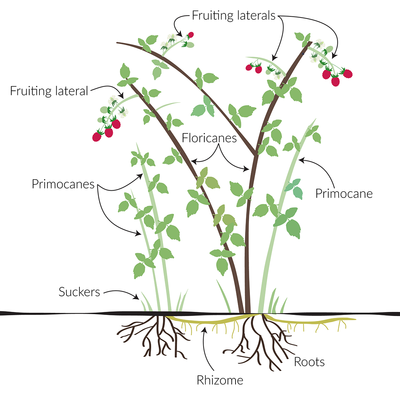
Primocane and floricane describe the stage of growth a raspberry cane or branch is in. Most raspberry varieties produce fruit only on floricanes, but some varieties have been grown to also produce fruit at the primocane stage.
Primocanes are the green, fleshy stalks that grow each year. During the first year of growth, the new primocane develops brown bark, then goes through a dormant or rest period in winter and becomes a floricane during the second growing season.
Harvest fruit from primocane-bearing varieties in mid to late summer.
Floricanes are woody and brown; they are the second-year growth. The floricane produces fruit in early to mid summer and then dies.
Care through the seasons
For summer-bearing (floricane) red, yellow, black, and purple raspberries:
-
March—For red and yellow raspberries, cut canes back to 4-5 feet tall before growth begins
- March—For black and purple raspberries, cut side branches back to 12-18 inches; prune all but 4 to 5 canes per hill to the ground
- April, May—Plant bare-root transplants as soon as the soil can be worked
- May, June—Plant potted transplants after threat of frost has passed
- June through August—Keep an eye out for spider mites and Japanese beetles
- July, August—Pinch black and purple raspberry cane tips
- July, August—Harvest
- August—Cut fruit-producing canes to the ground after harvest
- November—Apply mulch for winter protection
- November— Set up fence around plants if rabbit damage is expected during winter
For fall-bearing (primocane) red and yellow raspberries:
- March—For fall-only primocane raspberries, cut all canes to the ground before growth begins
- April, May—Plant bare-root transplants as soon as the soil can be worked
- May, June—Plant potted transplants after threat of frost has passed
- June through August—Keep an eye out for spider mites and Japanese beetles
- August, September—Harvest
Raspberries begin to bloom in late May or early June. Bumblebees, honeybees, and other wild bees are excellent pollinators of brambles. The more bees working your plants, the more fruit you will harvest.
How different raspberry varieties grow
Red and yellow raspberries produce many new canes from the base of the floricanes and from buds produced on the roots that become underground stems or stolons. The plants can spread in any direction. Thus "raspberry patch" is an apt name if the canes are not controlled through pruning.
Black and most purple raspberries produce primocanes only from the buds at the base of the floricanes. These clumps or "hills" stay where you originally plant them.
Everbearing red raspberries, also called "fall-bearing" or "primocane-fruiting" raspberries, are able to grow flowers during the first year. These varieties produce fruit at the tips of the primocanes. During the second year, they can produce a summer crop on the lower part of the same canes.
One problem with this type of raspberry in Minnesota is that in areas with a short growing season, many berries may be lost to early autumn freezes. Pruning of fall-bearers may be adjusted to allow for both a fall and following summer crop, or to take just the fall crop.
Varieties
The University of Minnesota Agricultural Experiment Station has been testing varieties for many years to find those best suited to our climate. This list is based on that research. Most of the varieties on the list are hardy throughout Minnesota; those with hardiness described as "fair" or "poor" will perform best in protected sites and in the southern part of the state.
There are many more varieties available, with more being released every year, that may be hardy to some areas in Minnesota. If winter injury is a concern in your garden, primocane-fruiting varieties may be the best choice.
Red raspberry varieties recommended for northern gardens
Yellow, purple and black raspberry varieties recommended for northern gardens
Planting
Early spring is the best time to plant raspberries. Choose a planting site that is in full sun. The plants will grow in part shade, but will not produce as much fruit.
Raspberries prefer rich, well-drained soil. A couple inches of compost mixed into the soil prior to planting will create a high quality planting site. A good rate is about 3 1/2 cubic feet of compost per 100 square feet.
Till the soil well before planting.
|
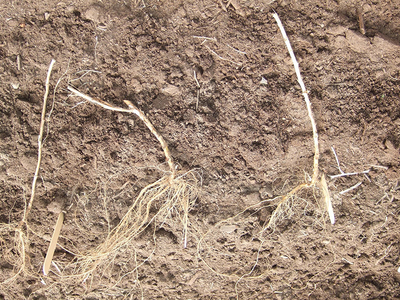
- Grow raspberries in a part of the garden that has good air circulation, good drainage and full sunlight.
- Good air movement helps leaves dry faster, which reduces disease problems. Standing water will increase the likelihood of disease problems and death of the plants due to a lack of oxygen to the roots.
- Any well-drained soil is good for growing raspberries. Irrigation will be needed on a sandy soil, and even on more moisture-retentive soils during dry spells.
- Raspberry canes are sensitive to drying out, so avoid planting in a very windy spot.
- Raspberries begin to bloom in late May or early June. Bumblebees, honeybees, and other wild bees are excellent pollinators of brambles. The more bees working your planting, the more fruit you will harvest.
Planting raspberries in a row along a fence or wall makes them easy to manage and, best of all, easy to pick. Or you can grow your raspberries in more of a rounded patch. Either way, space red or yellow raspberry plants every 2 to 3 feet.
Whether you're planting bare-root or potted plants, the key is to keep the crown of the plant 1 or 2 inches above the ground.
Dig a hole based on the size of the root mass
- When you place the plant in the hole spread out the roots.
- Try not to wrap the roots around in the hole.
- If any roots are particularly long or unruly, they can be trimmed off.
- If planting a potted plant, make sure to loosen the root ball and cut any tightly wound roots. This will help the roots spread better once planted in the ground.
Allow new primocanes of red and yellow raspberries to spread along the row or in between plants but not wider than 12 inches. Wider than that and the plants will be difficult to manage and harvest, and more prone to fungal diseases because of slow drying conditions.
Set black and purple raspberries 4 feet apart
Because these types do not produce root suckers, they will create what is commonly called a hill. The "hill" is not made by mounding the soil; it refers to the cluster of canes that develops from a single plant.
Although black and purple raspberries do not send up new primocanes outside the hill, they can spread. The long, vigorous canes often arch down to the soil surface, where they may take root. It's important to keep the canes controlled and supported to prevent this.
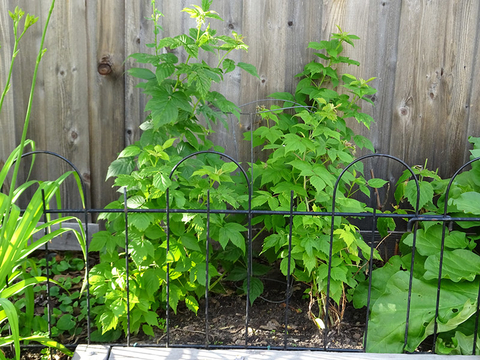
Watering
Raspberries need lots of water from spring until after harvest. Because the root system is in the top two feet of soil, watering regularly is better than an occasional deep soaking.
Raspberries need 1 to 1.5 inches of water per week from flowering until harvest. Use a rain gauge or check reported rainfall, and irrigate accordingly.
Support
All types of raspberries require support to prevent the canes from wind damage, bending over, cracking, and getting out of control.
A trellis can be as simple as a couple of posts and twine for a row of plants, or a decorative obelisk, teepee or arbor for individual or mass plantings.
Supporting the plants will not only keep them healthier and more productive, but it will also keep them looking nice.
Plant sturdy ornamentals like yarrow, echinacea or rudbeckia, or perhaps herbs or other edibles like kale alongside your raspberries to create a beautiful mixed garden. These will help support the raspberries and invite beneficial insects into the garden.
See the video at the top of this page for ideas on how to trellis raspberries.
How to keep your raspberries healthy and productive
|
Fertilizer and mulch
Raspberry plants are heavy feeders and generally need to be fertilized. Composted manure is a good source of nutrients and can be incorporated prior to planting at a rate of 31/2 cubic feet per 100 sq. feet, to improve soil structure and provide nutrients.
On established plantings, apply the same rate for continued plant nutrition.
Raspberries enjoy a 2- to 3-inch layer of mulch. Good mulches for use in the home garden include leaves, lawn clippings, and wood chips or shavings because they are usually free of weed seeds.
Weeding
Keep the area around the base of raspberry plants free of weeds to prevent them having to compete for water and nutrients. Keeping the area weeded will also reduce the potential for insect and disease problems.
Remove weeds early and often. A layer of mulch will help control weeds.
Red and yellow raspberry plants send up shoots or suckers in places you would least expect. If you discover suckers outside the area intended for your raspberry plants, cut them to the ground.
Remember, those suckers are attached to spreading roots, so it's a good idea to use a shovel to sever the roots. This will likely be a regular task for the raspberry grower.
Raspberries grow vigorously and need annual pruning. This keeps the plants looking good, increases productivity and reduces the chance of diseases.
Summer-bearing red and yellow raspberries
After the last harvest, cut all canes that have produced fruit to ground level and remove them. This eliminates a disease source and gives primocanes more room to grow.
- Thin primocanes to 4 to 5 sturdy canes per foot of row.
- In areas where winter injury is common, you may delay thinning the primocanes until the following spring, when you will be able to tell which canes have survived.
- Primocane growth may be somewhat reduced under this delayed-thinning method, due to competition among new canes.
- Before growth starts in spring, cut the canes to about 12 inches above the support.
- Don't cut back more than 25% of each cane, to avoid reducing yield.
Fall-bearing raspberries
Ifonly a fall crop is desired, cut all canes off at the base before growth begins in spring. Fruit will be produced on primocanes in late summer or fall.
To getboth fall and summer crops, thin the canes as described for summer-bearing raspberries. The primocanes that produced the fall crop should not be removed, as they will produce fruit the following summer. Prune them back in spring to about 12 inches above the support, or to the last visible node that had fruit, cutting off the dead tips.
Black and purple raspberries
- When primocanes are between 24 to 30 inches in height, pinch out the tip of each shoot to induce branching. This will make the fruit easier to pick and increase production.
- After harvest, cut down all canes that bore fruit to ground level.
- Before growth begins the following spring, cut back all side branches so they are 12 to 18 inches long.
- Select 4 to 5 canes per hill, and prune out the rest. Tie these canes to the support system.
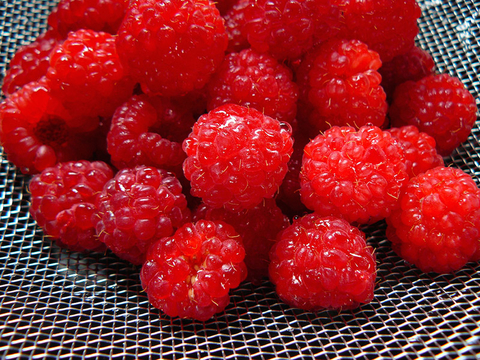
Raspberries of all colors are ready to pick when their color is developed and the fruit is plump and tender. Another indicator of ripeness is when the fruit comes off the plant easily when gently pulled.
Berries ripen over a couple of weeks, so simply pick them as they ripen.
Pick berries into a shallow container. If they get piled too deep they'll crush each other.
Right after picking, place raspberries in the fridge. If your fridge tends to dry out produce, lightly cover the container. Raspberries don't store for very long, usually just a few days.
Don't wash berries until you're ready to eat them; the moisture will cause them to break down more quickly.
Managing pests and diseases
Keeping plants healthy and well-cared-for is the best strategy for preventing a host of issues. When issues do arise, it is important to look closely at what you are seeing. Where is the damage located: leaves or fruit, primocanes or floricanes? Correct diagnosis is key in taking the right steps to address problems as they arise.
Find help identifying common pest problems:
- Use the online diagnostic tools What insect is this? and What's wrong with my plant?
- Send a sample to the UMN Plant Disease Diagnostic Clinic.
- Ask a Master Gardener allows you to share pictures and get advice.
|
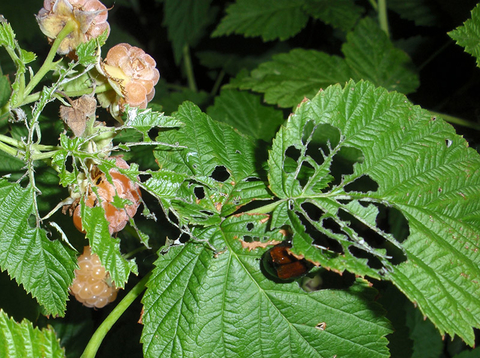
Fruit-eating insects
- Spotted wing drosophila are invasive fruit flies capable of laying eggs in ripening and ripe fruit, leading to mushy berries.
- Sap beetles are small beetles that are attracted to the smell of overripe fruit.
- Multicolored Asian lady beetle
- This invasive lady beetle species can be found feeding on the fruit in the fall, especially if the garden is located near a soybean field.
- They are attracted to sweet fruit.
- Beetles can have few or many spots, the identifying feature is a black "M" shape on the white band between their head and body.
- The best management strategy is picking fruit regularly.
- Corn rootworm
- These slender beetles are a quarter inch in length and range in color from yellow to tan to green.
- Beetles burrow into underripe and fully ripe fruit, destroying the berries.
- Beetles can often be found feeding in groups in late summer, and can do a lot of damage.
- Insecticides can be a helpful tool. Make sure to read the label carefully, especially to check for the amount of time needed between application and harvest.
- Yellowjackets
- Wasps are brightly colored, with yellow and black stripes.
- Wasps are attracted to overripe fruit, especially in the fall, so frequent picking will make the patch less attractive to them.
Cane and leaf feeding insects
- Gleaming bronze and bright green Japanese beetles can be seen mid-summer feeding and congregating on foliage.
- Flat-headed cane borers (red-necked cane borer, bronze cane borer)
- Occasionally cause scarring on raspberry canes, tip dieback, and cane death.
- Adults are small, metallic, and slender, larvae feed inside canes and are pale and maggot-like in appearance.
- Adults cause damage on the exterior of canes, leaving scars behind as they lay eggs, and can feed on leaves.
- Larvae feeding inside the cane cause a majority of the damage, causing tip dieback, galls, and dead canes.
- Observe plants for tip dieback, galls, and scarring, and if it is observed, prune to remove larvae.
- Spider mites can become an issue in hot weather, causing the underside of leaves to take on a bronze color.
- Misshapen, crumbling fruit can be caused by tarnished plant bug feeding.
- Potato leafhopper
- Leafhoppers feed on younger leaves, causing curling, yellowing, and stunting.
- These mobile, jumping insects can become an issue during periods of hot, dry weather.
- Adults are elongated, small (1/8 inch), and wedge-shaped.
- Natural enemies can help keep populations in check.
Rabbits are partial to raspberry canes in winter and will eat them, thorns and all, right down to the ground or the snow line. This is particularly damaging for summer-bearing raspberries, while fall-bearing raspberries are typically mowed down every spring anyway.
A simple chicken wire fence around your raspberry plants should protect them from rabbits throughout the winter.
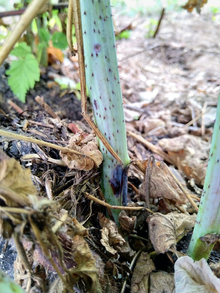
To properly diagnose pest problems on raspberry plants, it is important to understand the normal growth pattern of these plants.
When trying to identify what is killing leaves or canes, always check to see if the symptoms are on the primocanes or floricanes. Since floricanes die in the middle of summer, yellow and dying leaves on floricanes after June is considered normal, but yellow leaves on primocanes may indicate a problem.
Diseases can be limited by planting certified disease-free plants, destroying wild or abandoned brambles near the garden, and removing weak and diseased plants in established plantings.
After harvest, remove and destroy canes that have fruited or are weak.
One of the most effective measures is to improve air circulation by proper thinning and pruning and by controlling weeds.
Keep an eye out for spots, discoloration, parts of the plants dying, or moldy growth on leaves or fruit.
Cane blight
Cane blight is a common reason for the dieback of canes on raspberries. Disease lesions near the base of the cane cutoff water and nutrient transport to the rest of the cane, causing it to die.
Read more about raspberry cane diseases.
Gray mold
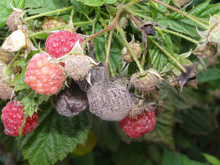
Gray mold is the most common fruit rot disease of raspberries in Minnesota.
-
The disease likes cool and wet weather during flowering and harvest.
-
Gray mold causes raspberry fruit to rot and become moldy while still on the plants.
-
In ripe fruit, gray mold may not appear until after picking and spreads quickly in a container.
-
Choose planting sites with full sun, good soil drainage and air circulation.
-
To manage this disease, plant in narrow rows, remove weeds often and thin plantings that have become overgrown.
-
In strawberry patches with a history of gray mold, remove and discard all straw in early spring. Replace with fresh straw or other organic mulch.
-
Fungicides can be used to manage gray mold fruit rot.
Phytophthora crown and root rot
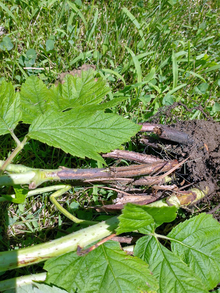
In raspberries, phytophthora crown and root rot causes canes to die back, due to an infection at the crown, or base, of the canes. The crown is located at or just beneath the soil surface.
Phytophthora infection causes brown discoloration on the outside and inside of the crown. It thrives in wet soils.
Positive confirmation of phytophthora infection is necessary before diagnosing and treating it. Dig up and submit an infected crown to the Plant Disease Clinic for diagnosis.
Prevent this disease with good site selection and cultural practices:
- Plant on well-drained soils, avoiding heavy, water-logged soils.
- If planting on heavier soils, create raised rows or raised bed gardens before planting, to increase water drainage.
- Do not overwater your raspberry patch.
- If you remove an infected raspberry patch, wait several years before planting raspberries there again. Choose a better area for your next planting if possible.
Heat damage
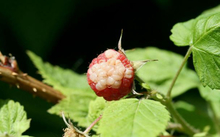
Hot days with strong sunlight may cause sunscald on berries forming white or colorless drupelets (the small, individual, seed-containing parts of each berry). The white drupelets will be flavorless, but there is no harm in eating them.
Once the weather cools, plants will produce normal berries. Heat can also cause berries to ripen faster than you can pick them, which can attract insects. Pick ripe fruit immediately.
Winter injury
Very few raspberry varieties are completely hardy in Minnesota. Even hardy varieties can exhibit symptoms of winter injury following severe winters. Winter injury can also occur after winters when the temperature fluctuates between mild and extremely cold.
Winter injury is often confused with cane blight, but it has symptoms that are different from other diseases.
- The tips of the canes are most susceptible to winter cold.
- Mild winter injury will result in the death of the top few inches of a cane.
- With severe winter injury, the top few feet of the canes will die.
- In almost all cases of winter injury, there will be healthy leaves at the bottom of the cane.
- If the winter injury occurred with a few inches of snow, then the canes die to snow level and will produce healthy leaves and fruit from the lower canes.
Raspberries that produce flowers and fruit on first year canes (primocanes) will always show some dieback in the spring. Dieback in fall-bearing raspberries is normal and is not considered winter injury.
Flowering in primocanes always starts at the tips of the canes and later flowers sprout lower in the cane. Any part of the cane that produces flowers will die in the winter. Always choose varieties that are suitable for your zone in Minnesota.
Leaf spot, spur blight, cane blight and anthracnose can make raspberries more susceptible to winter injury. Healthy plants will survive the Minnesota winters better.
For new raspberry patches
For established raspberry patches
Reviewed in 2021
What Garden Tool Do I Need To Cut Wild Plant
Source: https://extension.umn.edu/fruit/growing-raspberries-home-garden
Posted by: simpsonderignatim.blogspot.com

0 Response to "What Garden Tool Do I Need To Cut Wild Plant"
Post a Comment